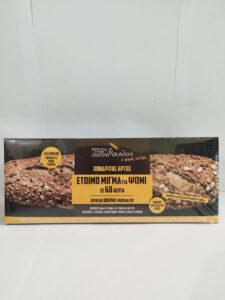The health benefits of zea
Two-grain wheat is used for human food, but it is also used as animal feed. It is used to produce a type of bread that is in great demand, particularly in Italy and Switzerland. Its flour is also used to make pasta, biscuits and other bakery products.
This type of wheat does not have the allergenic properties of other types of wheat because it does not contain the genes that cause allergies. Although it does contain gluten, it is in small amounts and is minimally allergenic and very easy to digest.

This gluten is tolerated by people who have a problem with gluten-induced allergy because two-grain wheat contains a substance, “rhodanine”, which is an immune-boosting agent.
It also contains large amounts of minerals, especially magnesium, containing 10-20 times more magnesium than common wheat.
This property enables it to be a food that is considered to have antidepressant effects. Its vitamin content, especially of the B group, and slow-digesting sugars are also important.
It also contains provitamin A which acts on good vision and the prevention of dry skin. Furthermore, it contains vitamin E, which is a powerful antioxidant.
Historical background
Lately various versions have been written about whether the ancients ate zea or whether they had it only for animals.
For thousands of years it remained the main cereal of the Middle East and North Africa. It was later replaced by Triticum turgidum (Durum) which was probably created from Triticum dicoccum by mutation. Farmers preferred this new cereal because the seed separated from the husk more easily. The cereal Triticum dicoccum, or Emmer or aja as it is called in Africa, arrived in Ethiopia 5 000 or more years ago and has survived to the present day.
Zea reduces cholesterol
Due to its high content of fibre and amino acid complexes, its consumption by humans reduces cholesterol in the blood.
Also, this wheat promotes good blood circulation.
Due to its glycemic index of 40, this grain regulates blood glucose and is therefore recommended in the diet of diabetics.
It is very rich in protein, reaching 13-20%, unlike common wheat which has 11-12%. The proteins it contains consist of all the essential amino acids, whereas common wheat does not contain lysine. Lysine and its other essential amino acids (tryptophan, methionine, thionine, valine, leucine, isoleucine, phenylalanine) are mainly found in the bran. Lysine makes the pasta produced by Zea particularly digestible.
Two-grain wheat contains twice as many lipids as common wheat and even contains polyunsaturated fatty acids comparable to those found in olive oil. Two-grain wheat in Bavaria is also used in the production of a well-known beer. In addition to other things, two-grain wheat has a very good taste and aroma.
What are the magical properties of zea?
- Zeus pasta contains 40% more magnesium and is much lighter than ordinary pasta.
- The magnesium additionally activates the enzymatic processes of metabolism.
- It contains high levels of the amino acid lysine, which makes pasta made from Zeus pasta highly digestible.
- Lysine also strengthens the immune system and is an essential element in the biochemical function of the brain.
- It is high in protein, fibre and minerals.
- It aids in the absorption of nutrients, suppresses chronic inflammation and is thought to prevent the development and metastasis of cancer.
Nutrients of zea:
Per 100 g contains: energy 1414 kj (338 kcal), carbohydrates 66.3 g, fibre 10.6 g, fat 1.63 g, protein 1-0.34 g, vitamin A 11 IU, thiamine (B1) 0,316 mg, riboflavin (B2) 0,251 mg, niacin (B3) 4,270 mg, pantothenic acid (B5) 1,456 mg, vitamin B6 294 mg, folic acid 38 mg, vitamin E 0,85 mg, vitamin K 5,9 mg, calcium 24 mg, iron 2,63 mg, magnesium 110 mg, phosphorus 332 mg, potassium 510 mg, sodium 2 mg, zinc 2,65 mg, manganese 2,577 mg.
The zea is suitable for:
- Reducing cholesterol
- Prevent cardiovascular disease
- Prevention of cancer
- Diabetes
- Menopause
- Digestive health
- Weight loss




Reviews
There are no reviews yet.